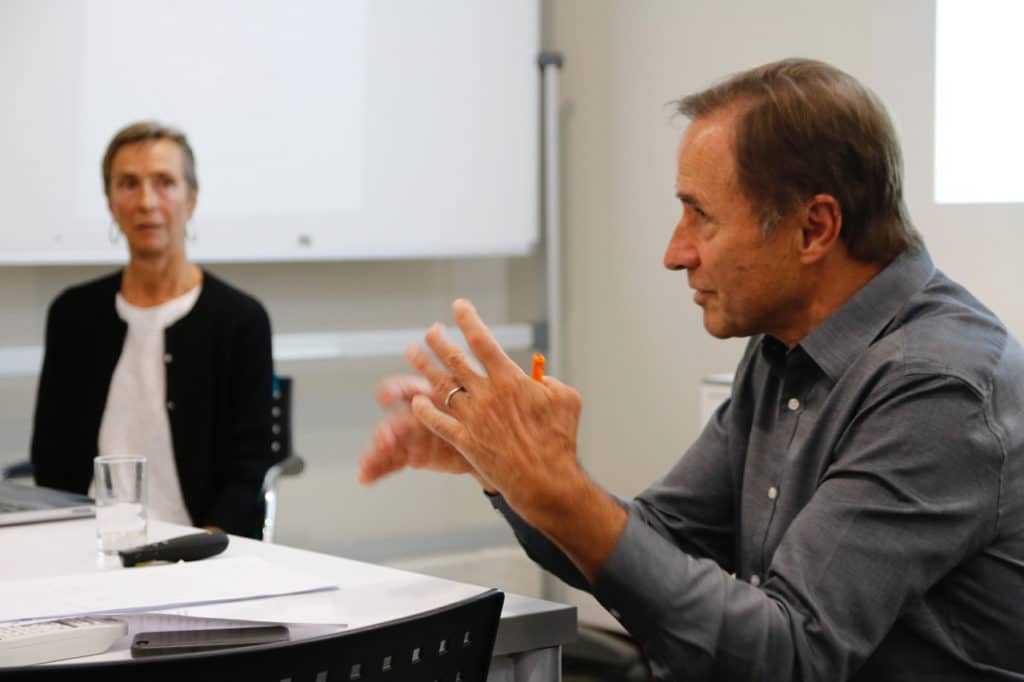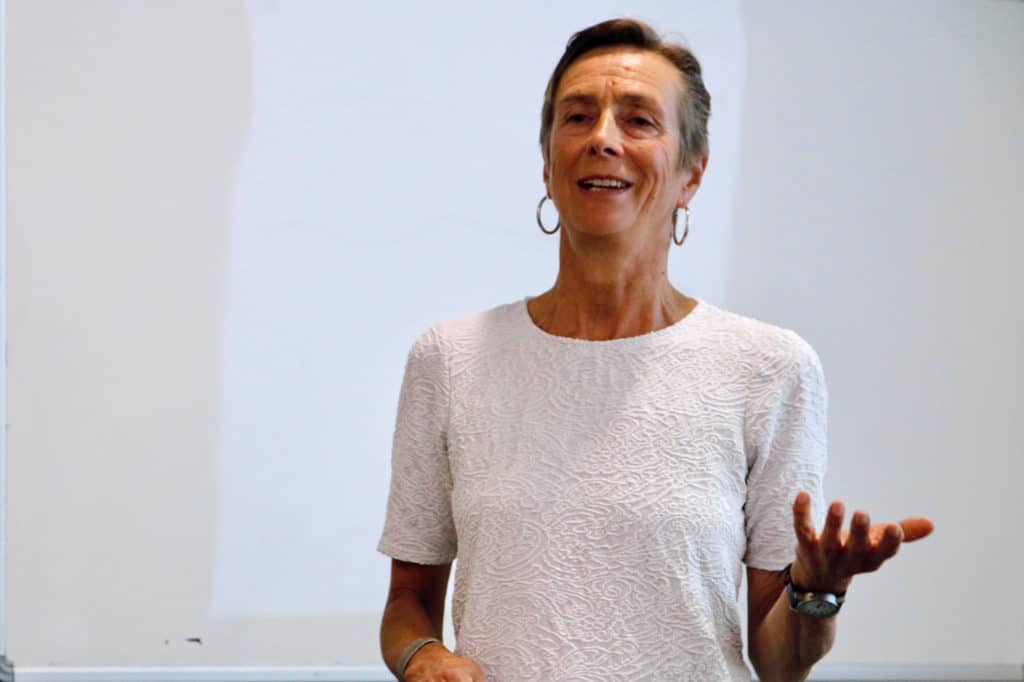“In order to raise living standards for its people, Africa cannot follow the road of development Europe or Asia have paved. There is just not enough time. In addition, Africa cannot afford to repeat the fatal errors the early industrialised countries made during their development, which was accompanied by extensive use of fossil fuels and high greenhouse gas emissions or agriculture that is extremely productive but causes soil erosion, biodiversity losses, groundwater pollution, etc. Africa needs fast, innovative and sustainable transformation. Therefore, Africa could and should fundamentally retool development and leapfrog its way into the future, achieving sustainable technology and innovation directly without costly detours of intermediate technological stages.”
This was the opinion expressed by Reiner Klingholz and Sabine Sütterlin of the Berlin Institute of Population and Development in their presentation to STIAS fellows. The institute is a private, non-profit, think-tank which focuses on demography and development.
They presented data and information from their study which concentrates on three sectors crucial for development: health, education and agriculture, and highlighted projects in these areas which they see as having leapfrogging potential for other countries in the region. They believe these three areas have far-reaching impact.
“Improvements in these sectors reduce high fertility rates, have a positive impact on population dynamics and create a favourable age structure that can open the window for a demographic dividend, enabling economies to enhance economic growth and improving living conditions dramatically,” said Klingholz.
“We are looking for best-practice examples in Africa and seeing if they are up-scalable and transportable,” he explained.
He presented data which show the huge disparities in development indicators.
“African countries rank low in almost all development indicators,” he said. “People in many parts of the continent face a pre-industrial, agrarian lifestyle with low incomes, low education levels, and high fertility rates. Productivity in agriculture is too low to feed even today’s population. Hundreds of millions of residents do not have access to electrical power or safe drinking water. This leaves a number of countries in a trap of poverty and high population growth.”
“Population growth can be seen as the biggest problem, because economic development and the supply of jobs cannot cope with it,” he said. “Countries across the world are either on a growing or shrinking pattern. The largest population growth is in Africa – the population is 1.3 billion today but will double to 2.6 billion by 2030.”
He highlighted Nigeria, where the population will double to 400 million by 2050 making the population density as high as that of Holland.
“If we look at Niger, for example, the current population is 23 million,” he said. “With each woman on average having seven children, this means a population of 63 million by 2050. There are 200 000 paid jobs but 700 000 new people are added to the labour market every year.”
“Sub-Saharan Africa, in particular, is behind in reducing fertility rates.”
“Socio-economic development, better health, enhanced education, increased income and gender equality all lead to decreasing fertility,” he said. “This has happened across the globe including in low- and middle-income countries like Bangladesh, Thailand, Turkey, Vietnam and South Korea which was poorer than any African country after the Korean War and is now one of the 15 strongest economies.”
“We need to reduce child mortality, raise education levels, offer decent work and promote gender equality. And, importantly, governments need to take the lead in highlighting the advantages of having smaller families. Africa needs to do all of this as fast as possible.”
Health burdens
Turning to the health sector, Sütterlin pointed out that average life expectancy in Africa has increased from 37 years in the 1950s to 63 now.
“However, it still lags behind the rest of the world by 10 to 15 years. A lot is due to infectious diseases – malaria, TB, and HIV specifically, along with pneumonia, diarrhoea and undernutrition. There is also now a rising prevalence of non-communicable diseases.”
“Sick people don’t go to school or work – so this hinders socio-economic development,” she added. “We also know that health deficits in one generation are transferred to the next.”
“The health systems struggle due to lack of resources, infrastructure and skilled people. African countries have the lowest numbers of doctors per capita.”
“Health services in some countries are also hindered by lack of access, distrust, violence and conflict,” she added.
“Leapfrogging is not about fancy technology or high-end, expensive medication but is about accessing state-of-the-art knowledge and using technology innovatively.”
In this regard she highlighted the Health Extension Programme in Ethiopia which established health posts staffed by lay health workers. This project has shown impressive outputs when evaluated after 12 years – including halving infant and under-5 child mortality via enhanced hygiene information, immunisation coverage and nutrition; as well as increasing contraceptive use and reducing HIV incidence.
“A relatively low investment helped to close a huge gap,” she said.
She also focused on the use of mobile phones for health highlighting the MomConnect app used in South Africa – offering information to pregnant women “which was launched in 2014, had 2.8 million registered users so far and 600 new users per month from Khayelitsha alone” as well as the Ada app which provides general health information.
“Digitisation provides an additional boost,” she said. “Mobile technologies offer huge potential for health in Africa. Saving time and costs, and helping with healthcare worker shortages.”
Turning to education, Klingholz pointed to the ongoing problem of low literacy rates on the continent; problems in the quality of teaching offered; and, the problem of absent or ‘ghost’ teachers which cost economies a fortune.
“Young people are vital for economic restructuring and development but youth alone is not an economic dividend. Only when fertility rates are reduced, when the young adults in working age become the biggest cohort in the population pyramid and jobs for these people can be provided, the demographic dividend can boost the economy. Under these conditions youth is the biggest resource of the continent but only with education,” he said.
He highlighted a project in Liberia which, through the simple development of a database, identified 2000 ‘ghost teachers’ who could be replaced without additional expenditure. He also focused on the ‘Tusome’ programme in Kenya which sent support officers to schools to document activities using tablets in real-time. “After three years, reading rates doubled at a cost of $4 per child per annum,” he said.
“Future investment in education is hugely important,” he continued. “We need to fast-track the attainment of the SDG goal of 12 years of schooling and to focus specifically on education of girls to decrease fertility rates.”
In the agriculture sector, Sütterlin said that due to rapid population growth, the fact that the Green Revolution didn’t reach Africa, and the ongoing use of poorly adapted, outdated methods by smallholder farmers, yield per hectare is lagging and most African countries are unable to feed their populations.
“There is an urgent need to enhance productivity to achieve food security in the first place,” she said. “Second, higher productivity of agriculture shows a way out of poverty and will be a driver of development. There is a need for new technologies but also to avoid anything harmful.”
She highlighted a project in Nigeria which allows farmers to make immediate, low-cost measurements of soil humidity, acidity and nutrient changes, as well as a project in Senegal which is leading to increasing milk production and job creation in the dairy sector.
“We are not necessarily talking about global solutions,” she said. “It’s often small steps and using good knowledge no matter where it comes from.”
In discussion, Klingholz pointed out that leapfrogging is about encouraging faster development by omitting the destructive phases. However, it does not replace good governance and the development of economic and marketing infrastructure.
The discussion also focused on the diversity of the continent.
“Nothing will work if the particular histories, cultural issues, power relations and political and economic questions are not addressed,” he said.
“The cultural adaptation of any leapfrogging idea is a challenge,” added Sütterlin.
“Different types of overpopulation have to be addressed differently,” said Klingholz. “In some ways overpopulation in the rich, developed world is a bigger problem because it causes global problems – like climate change.”
“The argument that children are an investment for the future doesn’t work when population growth outgrows the resources to sustain it.”
Michelle Galloway: Part-time media officer at STIAS
Photograph: Christoff Pauw


